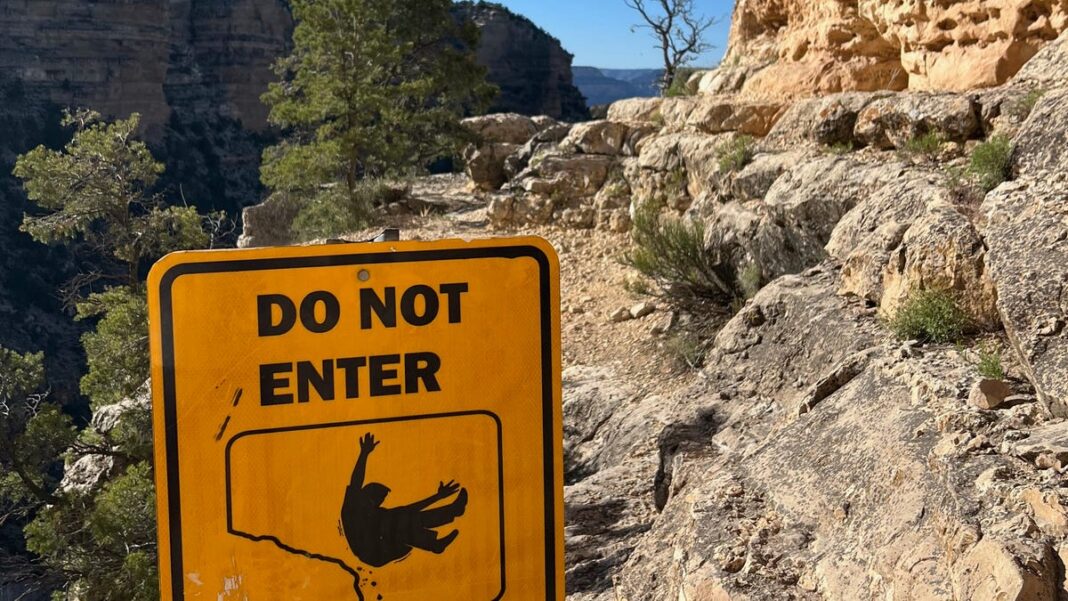Safety is a must: Essential tips for visiting any national park.
Among the possible risks at national parks — including wildlife encounters, severe weather, and the chance of getting lost — the biggest danger could be yourself.
According to National Park Service representative Cynthia Hernandez, “It’s not the parks that are dangerous by nature; it depends on how you prepare for your visit.”
Your decisions prior to and during your visit play a crucial role in ensuring your safety while exploring the parks.
“We want visitors to recognize the hazards, many of which can be mitigated by being prepared,” Hernandez stated.
Here’s how to ensure a safe trip to any national park.
How can you ensure your safety in a park?
“We emphasize that planning for your national park visit starts at home,” said Hernandez. “It’s important to think about your activities, specific destinations, transportation, lodging, required permits, and reservations.”
The official websites of national parks offer a wealth of valuable information. Additionally, the National Park Service’s online Trip Planning Guide can be a great resource. For further assistance, Hernandez recommends contacting the parks directly via information provided on their websites or through their social media channels.
Before heading out, it’s wise to check weather conditions for at least two weeks prior to your visit, including during the days you’ll be there, allowing ample time to acclimatize to different climate and elevation changes once you arrive.
“Weather conditions may feel similar to those at home, but if you’re in a higher elevation, altitude sickness can pose serious risks,” she cautioned.
When you arrive at the park, Hernandez recommends, “Even if you’re fully prepared, it’s a good idea to visit the visitor center.”
While you’re there, don’t forget to grab a map.
“It’s crucial that before you lose cell service, you either download a map through our app or pick up a physical map from the visitor center,” she emphasized.
Regardless of your destination, staying on designated trails is highly recommended, as you are more likely to encounter other visitors or park rangers if you need assistance.
Additionally, it’s essential to inform someone who is not accompanying you on your trip about your plans, including where you are going, how long you anticipate being out, and when you expect to return.
“Choose someone responsible who will check in on you to ensure you return to your lodging safely,” she advised. If they don’t hear from you as expected, they can alert park rangers or call 911.
Packing essentials for national parks
The National Park Service categorizes essential packing items into ten main categories:
- Navigation tools
- Sun protection (even in cooler weather)
- Insulating clothing
- Light sources
- First-aid supplies
- Fire-starting tools
- Repair kits and tools
- Food supplies
- Water supplies
- Emergency shelter
Besides multiple layers of clothing, Hernandez reminds visitors to wear appropriate footwear based on their planned activities. “Flip flops are not suitable for hiking up steep trails.”
Falls are the third leading cause of accidental deaths in national parks, resulting in 205 fatalities from 2014 to 2019, according to National Park Service statistics.
What is the leading cause of deaths in national parks?
The primary cause of unintentional fatalities in national parks is motor vehicle accidents, which have resulted in 354 deaths.
From 2014 to 2019, there were 314 unintentional deaths due to drowning, which was far higher than just 3 fatalities linked to wildlife in the same timeframe.
“Although swimming season may be over in many regions, swimming in national parks can be quite different from a pool experience,” Hernandez explained. “If you want to return home safely and plan to visit again, please wear a life vest.”
Self-Assessment
Before you head out on a hike or any challenging activity, it is essential to reflect and ask yourself: “How much water did I drink yesterday? Am I adequately rested? Am I wearing appropriate gear? Do I have a plan to turn back if I begin to feel unwell or experience any pain?”
It’s crucial to be honest with yourself and your companions during your adventures. Although you might have spent time and resources preparing for an activity, if you feel unwell, are short on water, or face any unexpected issues, voice your concerns and consider turning back.
According to Hernandez, “Being honest about your condition assists everyone in making more informed decisions. It’s much better to return home safely, even if you didn’t finish the trail or reach the summit, than to push beyond your limits and risk needing help or getting lost or injured.”
If your original plans don’t work out, remember that national parks offer numerous other attractions and activities.
Important Reminders for National Park Visits
While wildlife causes only a small number of deaths in national parks, it’s important to exercise caution around them.
“Avoid trying to touch or interact with wildlife in any way. Always maintain a safe distance,” Hernandez advised. “Keep pets away from wildlife, clean up after them, and never feed the animals.”
Visitors should remember that national parks are the natural habitats of these creatures, and we are merely guests in their environment. It’s our responsibility to respect wildlife by cleaning up after ourselves and leaving nature as we found it.

